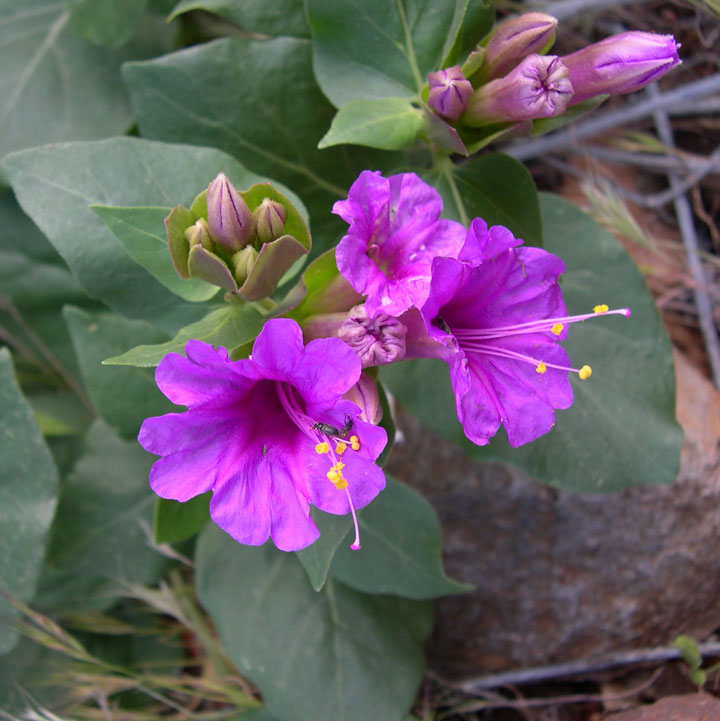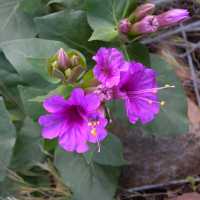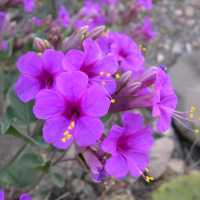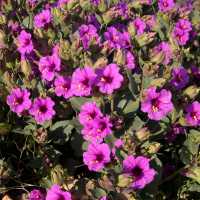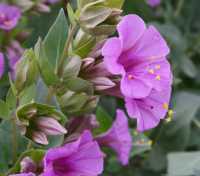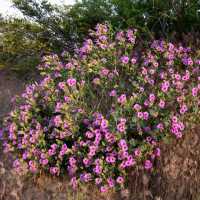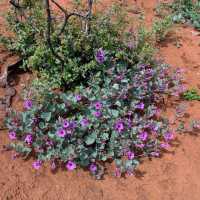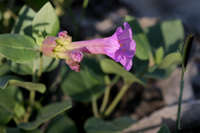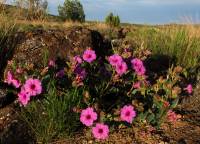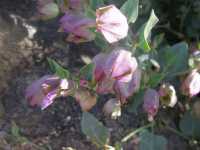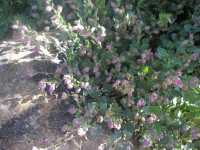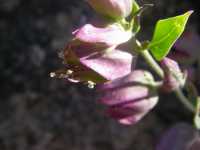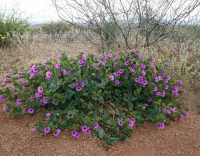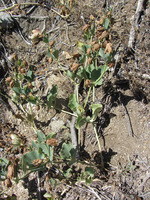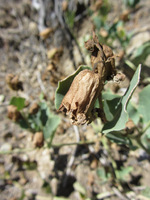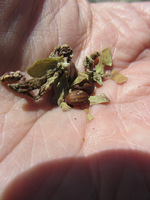Herbs, forming hemispheric clumps 6-10 dm diam., glabrous or densely pubescent. Stems 4-7 dm. Leaves spreading; petioles of proximal leaves 2-4 cm; blades of midstem leaves ovate to widely ovate, sometimes suborbiculate, rarely reniform, 5-10 × 4-8 cm, base rounded to cordate, often asymmetric, apex acute or acuminate to obtuse, rarely rounded. Involucres: peduncle 4-75 mm; involucres erect or ascending, 33-35 mm; bracts 5, usually more than 50% connate, apex acute to obtuse or ovate. Flowers 6 per involucre; perianth magenta, funnelform, 2.5-6 cm. Fruits brown to black, with 10 slender, tan ribs alternating with 10 dark brown ribs, or ribs inconspicuous, ovoid or globose, 6-11 mm, smooth to rugulose, glabrous or pubescent, secreting mucilage or not when wetted. 2n = 66.
G. E. Pilz (1978) recognized three partially sympatric varieties based on presence or absence of mucilage production in the fruits, fruit color, and apical acuteness of involucral bracts. Overall, populations are poorly differentiated, and in some areas plants represent a 'collage' (Pilz´s term) that combine characteristics of different varieties; S. L. Welsh et al. (1987) recognized no varieties. Mirabilis multiflora is used in the Southwest in a minor way in xeriscapes. Among indigenous peoples, it has been used as food and medicine (V. L. Bohrer 1975; L. S. M. Curtin 1947).
Duration: Perennial
Nativity: Native
Lifeform: Forb/Herb
General: Perennial herb to subshrub, forming hemispheric clumps 60-100 cm in diameter; stems 40-70 cm long, diffusely branched; herbage glabrous or densely pubescent.
Leaves: Opposite, on petioles 2-4 cm long; blades ovate to round, 5-10 cm long by 4-8 cm wide, with a rounded to heart-shaped, often asymmetric base.
Flowers: Large, showy, and purplish, arranged in clusters at branch tips; each cluster of 6 flowers surrounded by a cup-shaped, 5-lobed involucre, 3-4 cm high; petals fused into a funnel-shape, 2-6 cm long, magenta.
Fruits: Achenes ovoid to globose, 6-11 mm long, brown to black with 10 slender, tan ribs alternating with 10 dark brown ribs; containing a single seed.
Ecology: Found in gravelly and sandy soils, from the creosote flats of the low desert to the chaparral, and into the ponderosa forests from 500-8,500 ft (152-2591 m); flowers in spring and summer.
Distribution: CO and UT; south to n MEX
Notes: This incredibly distinctive perennial herb has large showy bell-shaped magenta flowers and and large fleshy oval to heart-shaped leaves. Flora of North America recognizes 3 varieties, all found in the Southwest. Var. glandulosa has warty (tuberculate) fruits that are mucilaginous when wetted, and the lobes of the involucre have obtuse tips (the involucre is the cup shaped structure that surrounds the clusters of flowers). Var. multiflora involucral lobes with acute tips, and the fruits are dark brown to black with inconspicuous ribs. Var. pubescens also has acute tips on the lobes of the involucres, but the fruits are lighter in color, with 10 slender, tan, longitudinal ribs that alternate with 10 brown, often interrupted ribs.
Ethnobotany: Used medicinally as a gynecological aid, to treat rheumatism, swellings, various mouth disorders, and as an antiseptic to wash out wounds; the root was chewed by a medicine man to induce visions; also used as a tea, as tobacco, and as a bird trap string.
Etymology: Mirabilis is Latin for miraculous or wonderful, alluding to the beauty of the plants; multiflora means many-flowered.
Synonyms: Oxybaphus multiflorus
Editor: SBuckley 2010, AHazelton 2017


